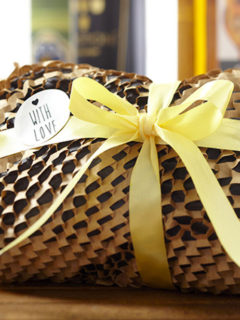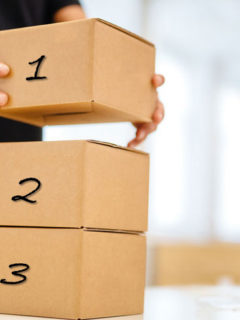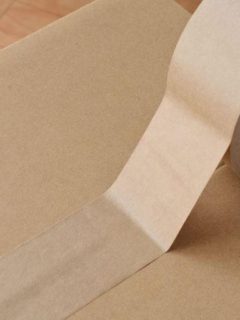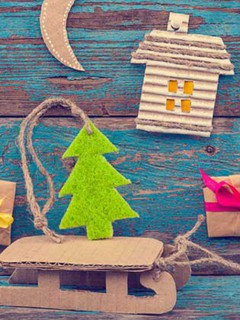Mirror, mirror on the wall… who has the most beautiful floor in the country? The floors in your business regularly need a touch of maintenance to stay in perfect condition. But there’s a catch: there are many different types of floors (parquet, tiles, linoleum, etc.), each of which requires its own cleaning method. When cleaning your floors, it is crucial to choose the right cleaner, brush or floor mop. Read on and see how to effectively clean your floors depending on the type of flooring.
1. Here’s how to choose the right cleaning product for your floors
Those who do not clean regularly will find that dust and dirt begin to accumulate which is far from ideal for the hygiene in your business. Floors that are not maintained will also wear out faster and need to be replaced. You obviously want to avoid that… The solution is simple: cleaning! And preferably on a regular basis.
However, every type of floor needs its own special ‘care’. This starts by choosing the right cleaning product. Those who want to clean their floors can choose from the following products:
- Detergents: these surface cleaners allow you to wipe away dirt and remove organic residues.
- Disinfectants: to eliminate bacteria, viruses and fungi as much as possible.
- Abrasives: for removing stubborn dirt on non-vulnerable surfaces.
- Solvents: for degreasing, sanitising and making your floors shine.
Note that natural products can be just as effective as chemical solutions. They are also less aggressive for cleaning your floors. Here are some common examples.
- White vinegar is a great solution for fighting grease, limescale, bacteria and unpleasant odours. In a lot of situations, you can also use it to clean your floors.
- Baking soda (bicarbonate) is a champion at removing stains and can be used to clean dirty floors.
- Black soap is a degreaser, disinfectant and stain remover. It not only cleans your floors but also makes them shine again.
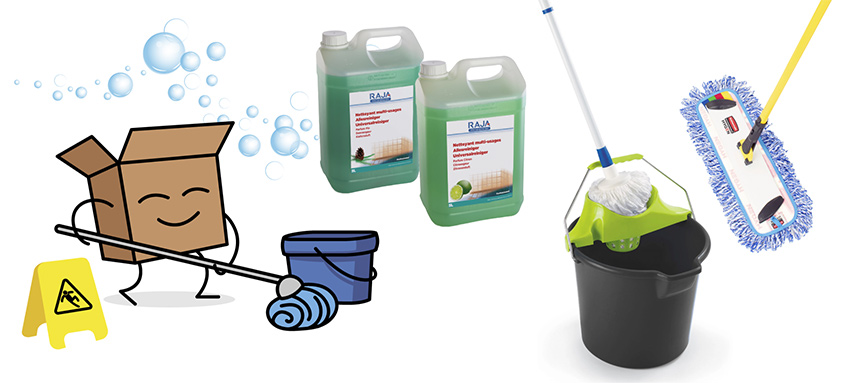
2. Choose the right cleaning technique for your carpets
Depending on the type of flooring in your business, shop or office, you can choose from the cleaning techniques and solutions below.
2.1 Parquet floor cleaning
You can find parquet in different types of designs (solid, laminate, waxed, oiled, sealed), each of which requires specific care. However, they all have one thing in common: they really hate water. This creeps between the boards and can cause the wood to swell and warp.
Parquet is one of the many floors that are best cleaned with a floor cloth. First wring out the mop well and then wipe the floor dry with a cloth. For maintenance, you can mix a little black soap or organic washing-up liquid with the water. However, avoid using white vinegar, as it can damage the wood. Finally, make sure to vacuum the floor regularly to prevent invaders (such as fleas, ants or termites) from attacking the wood.
Always be careful with waxed or oiled floors. These are particularly vulnerable and should not get wet. So cleaning them with water is out of the question!
2.2 Cleaning tiles
Stone tiles are the easiest of all types of flooring to clean. Simply use an all-purpose cleaner or water mixed with a cup of white vinegar to quickly remove stains. However, the real challenge lies in the joints between the tiles. It is important to thoroughly dab up the water that remains between the joints with a dry cloth. Especially in very humid areas (such as showers), this is crucial.
It is best to choose natural-based products when cleaning tiles. Too strong solutions, such as bleach, can damage the floor and corrode the joints.
2.3 Linoleum cleaning
Linoleum is a highly flexible type of flooring made from organic materials (wood particles, linseed oil, chalk, cork). It requires regular and careful maintenance. To wash the floor, you can use soapy water mixed with white vinegar. Remember to always wring out the mop well and rinse regularly to avoid streaks. Above all, don’t use too much water.
2.4 Cleaning concrete floors
You originally found concrete floors only in car garages or storage areas. Nowadays, they are also used as flooring in trendy homes, lofts and offices. It is an extremely sturdy material that is easy to maintain. To clean the floor, simply mop it with water mixed with the desired product (an all-purpose cleaner, for example). For stubborn stains (petrol, oil, etc.), sprinkle the floor with baking soda before scrubbing with a hard brush. It is important to rinse well after and remove all the water.
2.5 Cleaning plastic floors
Plastic floors are usually made of PVC or vinyl. They are widely used in healthcare, education, hotels or industry. To clean such a plastic floor, it is best to use a microfibre floor mop. You can dip that mop briefly in a mixture of water and white vinegar or baking soda. For areas with stricter hygiene measures, the use of a disinfectant may be necessary.
Keep in mind that plastic floors cannot tolerate strong products such as bleach or ammonia. Also avoid using abrasive materials (such as an abrasive cream).
2.6 Cleaning carpets
Carpets are often found in hotels, changing rooms and offices. However, maintaining and cleaning them requires some extra attention. Carpets have a nasty tendency to retain dust, hair and crumbs and form a cosy nest for dust mites, among other things. The best technique to clean these floors is to use a hoover. Choose a model with sufficiently high suction power to get rid of the most stubborn dirt. Once a year, by the way, you can choose to have your carpets cleaned with water. Specialist firms offer tailor-made solutions for this.
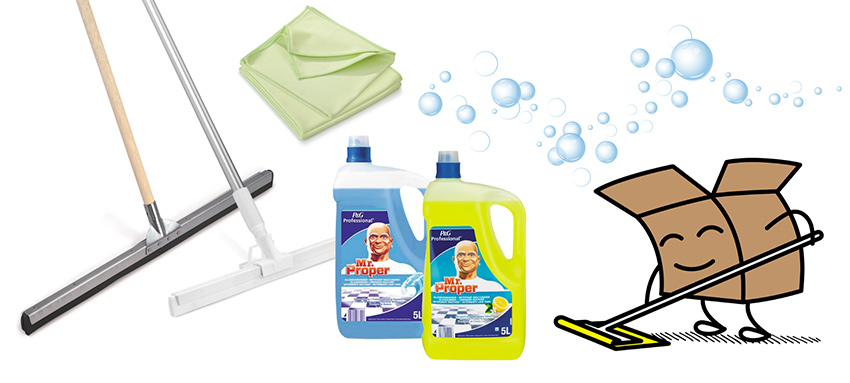
]
3. Five frequently asked questions about floor cleaning
3.1 Should you mop floors with hot or cold water?
When mopping floors, it is best to use cold or lukewarm water. Too hot water will evaporate quickly, leaving soap residue from the cleaning product on the floor. That soap residue can cause streaking which makes the mopping process less effective.
3.2 Can I clean floors with vinegar?
Vinegar can be especially useful for cleaning tile floors and vinyl floors, as it helps to remove stubborn stains and accumulations of dirt. However, not all floors are suitable for cleaning with vinegar. Wooden floors and natural stone floors, such as marble and granite, can be damaged by the acidic properties of vinegar. Vinegar is a cleaning agent of natural origin and contains powerful acidic properties. You can use it to remove dirt, stains, bacteria as well as odours.
3.3 When do I use a floor mop and when a mop?
Use a flat floor mop (with or without a cloth wrapped around it) to quickly wet clean large smooth surfaces. A mop is ideal for wet or dry cleaning. You can use it to clean smaller, hard-to-reach areas and remove stubborn dirt.
3.4 How can you make a mop smell better?
To make a mop smell fresher, you can use white vinegar or baking soda (bicarbonate of soda). Vinegar acts as a natural deodorant and can help remove unpleasant odours from the mop. Add a splash of white vinegar to a bucket of hot water and immerse your mop in it. After washing, rinse the mop well with clean water and hang it up to dry.
3.5 What is the best way to mop?
The best way to mop starts by vacuuming the floor. Then make a lather and wring out the mop well. Mop the floor and rinse the mop regularly. Then let the floor dry thoroughly. Always use the right cleaning product for your type of floor and preferably with cold water to avoid streaks.











